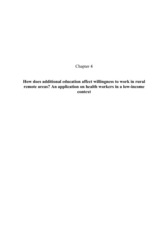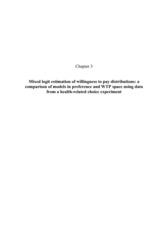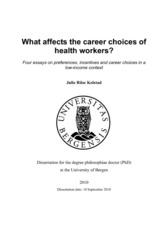| dc.contributor.author | Kolstad, Julie Riise | eng |
| dc.date.accessioned | 2011-01-19T08:48:14Z | |
| dc.date.available | 2011-01-19T08:48:14Z | |
| dc.date.issued | 2010-09-10 | eng |
| dc.identifier.isbn | 978-82-308-1583-0 (print version) | |
| dc.identifier.uri | https://hdl.handle.net/1956/4445 | |
| dc.description.abstract | The geographical imbalance of the health workforce in Tanzania represents a serious problem when it comes to delivering crucial health services to a large share of the population. TheTanzanian health system, like many others in low-income countries, needs better incentivesystems to attract dedicated workers to the health sector, to bring more qualified healthworkers to rural areas, and to induce them to use their knowledge and skills efficiently.However, creating better incentive and recruitment systems requires thorough knowledge ofhealth workers’ motivations and preferences, as well as the relative valuations of different jobattributes. The aim of this Ph.D. project has been to contribute to the base of knowledge abouthealth workers’ individual motivations and preference structures. It has also been animportant goal to examine how jobs with different characteristics can be matched with thesepreferences in order to provide high-quality health services on a larger scale.The first essay, ‘How to make rural jobs more attractive to health workers: findings from adiscrete choice experiment in Tanzania’, published in ‘Health Economics’ (2010), providesnew quantitative information about how health authorities can make jobs in rural areas moreattractive to newly educated clinical officers. A data set stemming from a discrete choiceexperiment with clinical officer finalists in Tanzania is applied. The results show that offeringadditional education after a certain period of service is one of the most powerful recruitmentinstruments the authorities have available. Increased salaries and hardship allowances are alsolikely to substantially increase recruitment in rural areas. Offers of decent housing and goodinfrastructure, including the provision of equipment, can also increase recruitment to ruralremote areas but not as much as higher wages and offers of education.In the second essay, ‘Mixed logit estimation of willingness to pay distributions: a comparisonof models in preference and WTP space using data from a health-related choice experiment’,co-authored with Arne Risa Hole, different approaches to modelling the distribution of WTPare compared using mixed logit models and the same data set as in essay 1. The standardapproach of specifying the distributions of the coefficients and deriving WTP as the ratio oftwo coefficients (estimation in preference space) is compared to specifying the distributionsfor WTP directly at the estimation stage (estimation in WTP space). The results suggest thatsensitivity testing using a variety of model specifications, including estimation in WTP space,is highly recommended when using mixed logit models to estimate willingness to paydistributions.In the third essay, ‘How does additional education affect willingness to work in rural remoteareas?: an application to health workers in a low-income context’, the main objective is toevaluate the effect of offering education opportunities as a strategy to recruit health workersto rural areas. A dataset capturing stated job preferences among freshly educated Tanzanianhealth workers with basic and more advanced clinical education is applied in order toinvestigate how additional education as an incentive mechanism affects the willingness towork in rural areas. In order to control for selection effects into the additional educationscheme, the two cadres are matched on propensity scores. It turns out that the health workerswith advanced clinical education would have been more likely to prefer a job in a rural remotearea had they not received the advanced clinical education. The result goes a long way insuggesting that a policy aiming at recruiting health personnel with basic clinical education torural remote areas by offering jobs that include possibilities of upgrading after a certain periodof service, may be a temporary measure only.The fourth essay, “Pro-social preferences and self-selection into the public health sector:evidence from economic experiments” co-authored with Ida K. Lindkvist, studies the extent towhich differences in pro-social preferences are related to career choices. We test whetherpreferences vary systematically between Tanzanian health worker students who prefer towork in the private health sector and those who prefer to work in the public health sector.Despite its important policy implications, this issue has received hardly any attention to date.By combining data from a questionnaire and two economic experiments, we find that studentswho prefer to work in the public health sector have stronger pro-social preferences than thosewho prefer to work in the private sector. We also show that the extent to which these studentscare about others can be conditional and linked to inequality aversion. A systematic selfselectionof pro-socially motivated health workers into the public sector suggests that it is agood idea to have two sectors providing health services: this can ensure efficient matching ofindividuals and sectors by allowing employers in the two sectors to use different paymentmechanisms tailored to attract and promote good performance from different types of health workers. | en_US |
| dc.language.iso | eng | eng |
| dc.publisher | The University of Bergen | eng |
| dc.relation.haspart | Paper I: Health Economics 20 (2), Julie Riise Kolstad. How to make rural jobs more attractive to health workers. Findings from a discrete choice experiment in Tanzania, pp. 196–211. Copyright 2010 John Wiley & Sons, Ltd. Full text not available in BORA due to publisher restrictions. The published version is available at: <a href="http://dx.doi.org/10.1002/hec.1581" target="blank"> http://dx.doi.org/10.1002/hec.1581</a> | eng |
| dc.relation.haspart | Paper II: Arne Risa Hole & Julie Riise Kolstad (2010), Mixed logit estimation of willingness to pay distributions: a comparison of models in preference and WTP space using data from a health-related choice experiment. Draft version. | eng |
| dc.relation.haspart | Paper III: Julie Riise Kolstad (2010), How does additional education affect willingness to work in rural remote areas? An application on health workers in a low-income context. Draft version. | eng |
| dc.relation.haspart | Paper IV: Julie R. Kolstad & Ida Lindkvist (2010), Pro-social preferences and self-selection into the public health sector: evidence from economic experiments. Draft version. | eng |
| dc.title | What affects the career choices of health workers? Four essays on preferences, incentives and career choices in a low-income context | eng |
| dc.type | Doctoral thesis | en_US |
| dc.rights.holder | The author | en_US |
| dc.rights.holder | Copyright the author. All rights reserved | en_US |
| dc.subject.nsi | VDP::Samfunnsvitenskap: 200::Økonomi: 210::Samfunnsøkonomi: 212 | nob |
| dc.subject.nsi | VDP::Medisinske Fag: 700::Helsefag: 800 | nob |



